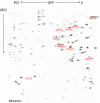A proteomic study of the differential protein expression in MDBK cells after bovine herpesvirus type 1 infection (BHV-1) strain treatment
- PMID: 26064331
- PMCID: PMC4443165
A proteomic study of the differential protein expression in MDBK cells after bovine herpesvirus type 1 infection (BHV-1) strain treatment
Abstract
Different BHV-1 strains, such as the virulent IBRV LN01/08 strains and the attenuated vaccine strain IBRV LNM, produces different clinical immune responses; however, the study of the differential protein expression in Madin-Darby bovine kidney (MDBK) cells after BHV-1-infection still remains unclear. Here, we applied a comparative proteomic strategy, based on 2D and MALDI-TOF/MS platforms, to examine the differential expression of proteins in MDBK cells that were treated and not treated with virulent IBRV LN01/08 and attenuated IBRV LNM strains. A total of eight differential proteins, including pyruvate kinase, heat shock protein (HSP) 90 (HSP90AA1 and HSP90AB1), annexin A, albumin (ALB), scinderin (SCIN), tubulin (alpha 1a) and vimentin (VIM), were identified. Among these proteins, pyruvate kinase, and HSP90 (HSP90AB1), tubulin and vimentin were identified in the virulent IBRV LN01/08 strain group, but were not identified in the attenuated IBRV LNM group. These results play an important role in tumor formation and development, cell migration, tumor cell line apoptosis, cell invasion and viral infection. The HSP90 (HSP90AA1) protein was identified in the control group and the attenuated IBRV LNM-infected group. Most studies have shown that HSP90 proteins were more of a cancer gene target, and inhibiting its function would result to oncogene degradation during cancer treatment. On the other hand, ALB is associated to cell differentiation, apoptosis, necrosis, cell death, viral infection, autophagy, interstitial tissue inflammation, and cell survival. These results provide a theoretical basis for the systematic understanding of BHV-1-infection mechanisms and BHV-1-induced immune responses.
Keywords: BHV-1; MDBK; comparative proteome.
Figures


Similar articles
-
Modulation of telomerase activity, bTERT and c-Myc induced by 2,3,7,8-tetrachlorodibenzo-p-dioxin during Bovine Herpesvirus 1 infection in MDBK cells.Toxicol In Vitro. 2014 Feb;28(1):24-30. doi: 10.1016/j.tiv.2013.06.020. Epub 2013 Jul 9. Toxicol In Vitro. 2014. PMID: 23850740
-
Antiapoptotic activity of bovine herpesvirus type-1 (BHV-1) UL14 protein.Vet Microbiol. 2007 Jul 20;123(1-3):210-6. doi: 10.1016/j.vetmic.2007.02.026. Epub 2007 Feb 28. Vet Microbiol. 2007. PMID: 17408888
-
Bovine herpesvirus 1 glycoprotein G is required for viral growth by cell-to-cell infection.Virus Res. 2000 Jul;68(2):175-81. doi: 10.1016/s0168-1702(00)00171-4. Virus Res. 2000. PMID: 10958989
-
2,3,7,8-Tetrachlorodibenzo-p-dioxin increases Bovine Herpesvirus type-1 (BHV-1) replication in Madin-Darby Bovine Kidney (MDBK) cells in vitro.J Cell Biochem. 2008 Jan 1;103(1):221-33. doi: 10.1002/jcb.21398. J Cell Biochem. 2008. PMID: 17516555
-
A review of the biology of bovine herpesvirus type 1 (BHV-1), its role as a cofactor in the bovine respiratory disease complex and development of improved vaccines.Anim Health Res Rev. 2007 Dec;8(2):187-205. doi: 10.1017/S146625230700134X. Anim Health Res Rev. 2007. PMID: 18218160 Review.
References
-
- Muylkens B, Thiry J, Kirten P, Schynts F, Thiry E. Bovine herpesvirus infection and infectious bovine rhinotracheitis. Vet Res. 2007;38:181–209. - PubMed
-
- Nandi S, Kumar M, Manohar M, Chauhan RS. Bovine herpes virus infections in cattle. Anim Health Res Rev. 2009;10:85–98. - PubMed
-
- Harrison SC. Principles of virus structure. Chapter 3. In: Knipe DM, Howley PM, editors. Fields’ virology. 4th edition. Volume 1. Philadelphia: Lippincott Williams & Wilkins; 2011. pp. 53–85.
-
- Wyler R, Engles M, Schwyzer M. Infectious bovine rhinotracheitis/vulvovaginitis (BHV-1) In: Wittmann G, editor. Herpesvirus diseases of cattle, horses and pigs. Developments In Veterinary Virology. Boston: Kluwer Academic Publishers; 1989. pp. 1–172.
LinkOut - more resources
Full Text Sources
Miscellaneous
